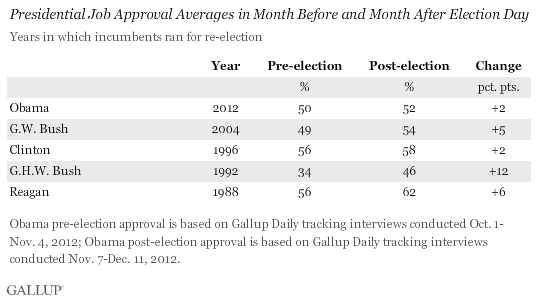PRINCETON, NJ -- President Barack Obama's job approval rating has increased slightly to 52% since Election Day, after averaging 50% in the month prior to the election. All recent incumbent presidents who ran for re-election saw at least a slight increase in their approval ratings after the election. The average bump is six percentage points for all presidents and four points for those who, like Obama, won re-election.

George H.W. Bush, the only recent incumbent defeated for re-election, saw the biggest post-election bump in approval, a 12-point increase. Bush's rating continued to rise in the final month of his presidency, and he left office with 56% job approval -- 22 points higher than before Election Day. Part of that increase may have been sympathy-related, after Bush was defeated. But part was also due to international rally events, including the sending of U.S. troops to respond to a humanitarian crisis in Somalia.
Bill Clinton and Ronald Reagan were the most popular recent presidents at the time they ran for re-election, and both won easily. But Reagan's approval rating increased slightly more in the month after the election -- by six points to 62% -- than did Clinton's, which rose two points to 58%.
George W. Bush -- whose 49% approval rating in the month before the election is most similar to Obama's -- got a slightly higher five-point bounce in support after winning re-election.
Gallup did not reliably measure pre- and post-election approval ratings for presidents prior to Reagan.
Implications
Obama's public support since the election is slightly higher than before it, although he did not see as much of a bump in his approval rating as other recent presidents did. The average increase has been six points, but that is inflated somewhat by George H.W. Bush's 12-point increase after he lost his re-election bid. The four recent presidents who won a second term received an average four-point increase.
Obama's most recent approval rating -- based on Dec. 10-12 Gallup Daily tracking, is slightly better at 54%. Still, he enters the final month of his first term as president in a weak position compared with other successful incumbents, whose approval ratings at roughly the same point ranged from 54% to 62%.
Explore President Obama's approval ratings in depth and compare them with those of past presidents in the Gallup Presidential Job Approval Center.
Survey Methods
Results for this Gallup poll are based on telephone interviews conducted Nov. 7-Dec. 11, 2012, on the Gallup Daily tracking survey, with a random sample of 17,656 adults, aged 18 and older, living in all 50 U.S. states and the District of Columbia.
For results based on the total sample of national adults, one can say with 95% confidence that the maximum margin of sampling error is ±1 percentage point.
Interviews are conducted with respondents on landline telephones and cellular phones, with interviews conducted in Spanish for respondents who are primarily Spanish-speaking. Each sample includes a minimum quota of 400 cellphone respondents and 600 landline respondents per 1,000 national adults, with additional minimum quotas among landline respondents by region. Landline telephone numbers are chosen at random among listed telephone numbers. Cellphone numbers are selected using random-digit-dial methods. Landline respondents are chosen at random within each household on the basis of which member had the most recent birthday.
Samples are weighted by gender, age, race, Hispanic ethnicity, education, region, adults in the household, and phone status (cellphone only/landline only/both, cellphone mostly, and having an unlisted landline number). Demographic weighting targets are based on the March 2011 Current Population Survey figures for the aged 18 and older non-institutionalized population living in U.S. telephone households. All reported margins of sampling error include the computed design effects for weighting and sample design.
The questions reported here were asked of a random half-sample of respondents each night on the Gallup Daily tracking survey.
In addition to sampling error, question wording and practical difficulties in conducting surveys can introduce error or bias into the findings of public opinion polls.
For more details on Gallup's polling methodology, visit www.gallup.com.
